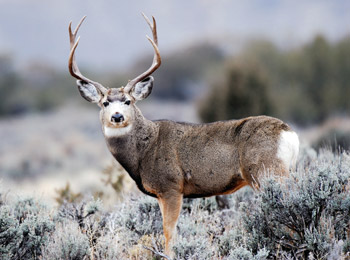UTAH – October 18, 2015 (Gephardt Daily) – Utah’s most popular hunt — the general rifle buck deer hunt — begins this weekend, and the Division of Wildlife Resources has some tips for success.
“There’s so much more to deer hunting than taking a deer,” says Kirk Smith, hunter education coordinator for the Division of Wildlife Resources. “Being in the mountains with your family and friends, enjoying the beautiful fall scenery and seeing the variety of wildlife that live in Utah can make any deer hunt a memorable experience.”
Smith provides the following tips for a safe and enjoyable hunt:
Personal preparation
- Be familiar with the area you’re going to hunt. If possible, scout the area before the hunt. “Scouting before the hunt is absolutely vital,” Smith says. “You need to know the conditions in the area and how deer are responding to those conditions. The better you know the area, the better chance you’ll have of taking a buck.”
- Put a survival kit together. The kit should include:
- a small first aid kit
- three ways to make a fire (e.g. matches, a cigarette lighter, fire starters)
- quick-energy snack foods
- a cord or rope
- a compass or Global Positioning System unit
- a flashlight
- an extra knife
- a small pad of paper and a pencil (if you become lost, you can leave information at your last location about yourself and the direction you’re traveling).
Preparing your firearm
- Be as familiar as possible with your firearm. Know how to load and unload it, and where the safety is and how to operate it.
- Make sure the barrel of your firearm doesn’t have any obstructions in it.
- Make sure you have the correct ammunition for your firearm.
- Visit a shooting range, and sight in your firearm. When you sight in your firearm, make sure you use the same ammunition you’ll use during the hunt. A list of shooting ranges in Utah is available on the DWR website.
Firearm safety
- Never carry a loaded firearm in your vehicle.
- Treat every firearm like it’s loaded.
- Always control the muzzle of your firearm. Never let the muzzle point at anything you don’t intend to shoot. And make sure you don’t accidently point the muzzle at yourself.
- Keep your finger off the trigger until your sights are on the target.
- Be sure of your target and what’s beyond it.
Vehicle preparation
- Make sure your vehicle is in good mechanical condition.
- Carry a shovel, an ax, tire chains, jumper cables and a tow chain in your vehicle.
- If you experience mechanical problems with your vehicle or you get snowed in, stay with your vehicle — don’t leave it.
Before leaving on your trip
- Let someone know where you’re going and when you expect to return.
While in the field
- Never hunt alone.
- Wear proper safety clothing: 400 square inches of hunter orange on your back, chest and head. This is the minimum amount that’s required. “I’d recommend that you wear even more,” Smith says. “Hunter orange really helps you stand out to other hunters.”
Field dressing your animal
- Use a sharp knife. A sharp knife cuts better than a dull knife and is safer to use.
- Cut away from you. Never bring a knife blade towards you while cutting.
Your physical well-being
- Know your physical limitations, and don’t exceed them.
- Prepare yourself for weather changes by dressing in layers. Dressing in layers allows you to regulate your body temperature by adding or removing clothes as needed.
- Drink plenty of water, no matter how cold it is. “You can still become dehydrated,” Smith says, “even in cold weather.”
- Hypothermia (the loss of body temperature) can occur in temperatures as warm as 50 degrees.Be aware of the signs of hypothermia. Some of the first signs are violent shivering, stumbling or becoming disoriented. “If you notice these signs,” Smith says, “sit down immediately, and build a fire. Get yourself warm and dry as fast as you can.”
- Frostbite. If you’re hunting in cold weather, watch for signs that you’re getting frostbite. White spots on your skin are the first sign. Check your face, feet and hands regularly. You’ll notice the first signs of frostbite on your face sooner if you’re hunting with a companion who can alert you.
If you get lost
- Don’t panic. Sit down and build a fire, even if it isn’t cold. Having a warm fire to sit by has a soothing effect. “Building a fire will help you relax and think clearly,” Smith says.
- After calming down, try to get your bearings and think your way out of the situation. If you think you know the direction you need to travel, get the pad of paper and pencil out of your survival kit, and leave a note at your location. Indicate on the note who you are and the direction you’re traveling. If you find other hunters, don’t be embarrassed to ask them for help and directions.
- If you don’t know which direction you should travel, stay at your camp. If possible, build a shelter several hours before sundown. Build a smoky fire (this type of fire can be spotted from the air) or build three fires (a distress signal that can also be spotted from the air).
- Remaining at your camp is usually a good option. “Many people don’t know this,” Smith says, “but you can live without food and water for several days. Staying at your camp is usually a good choice.”






